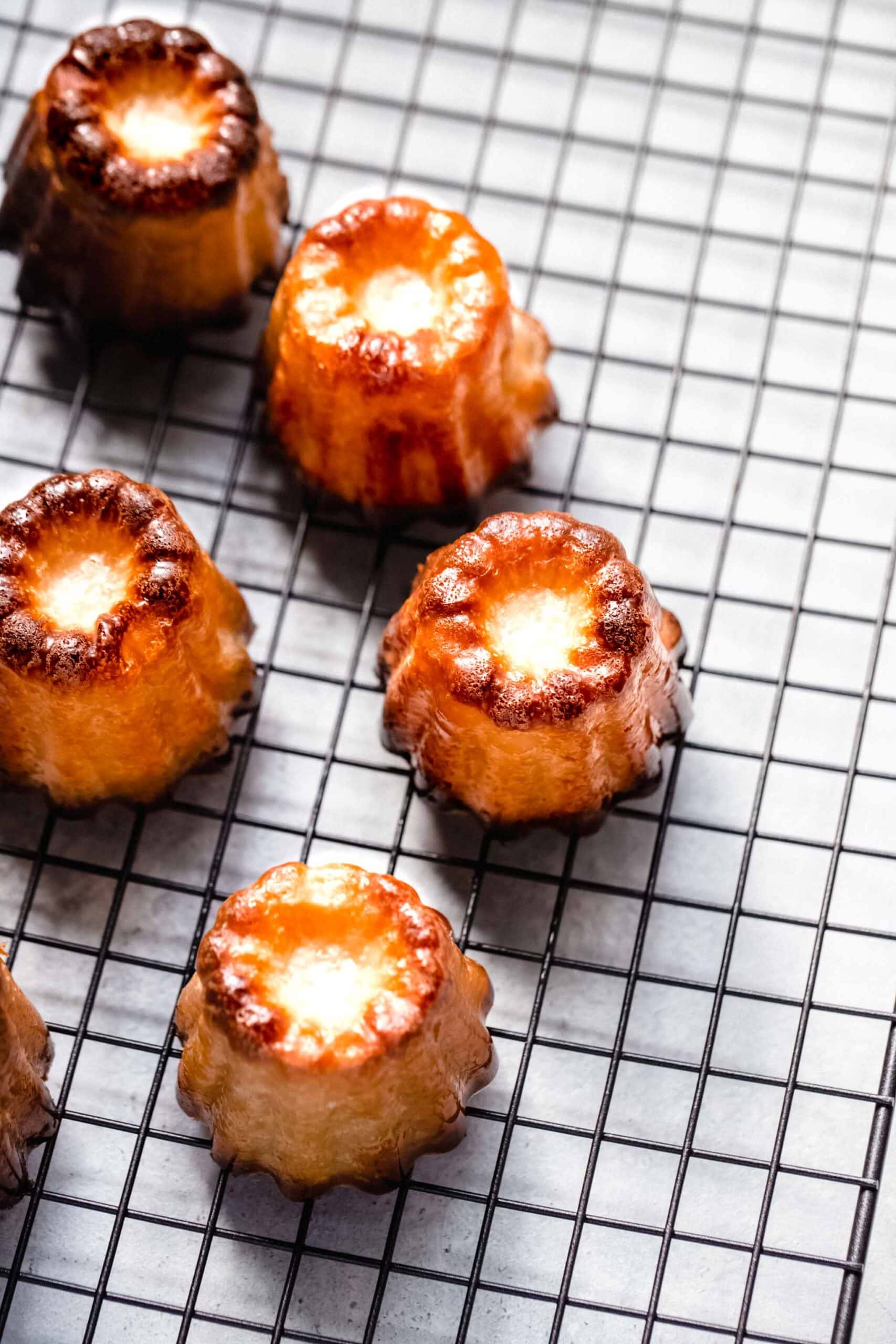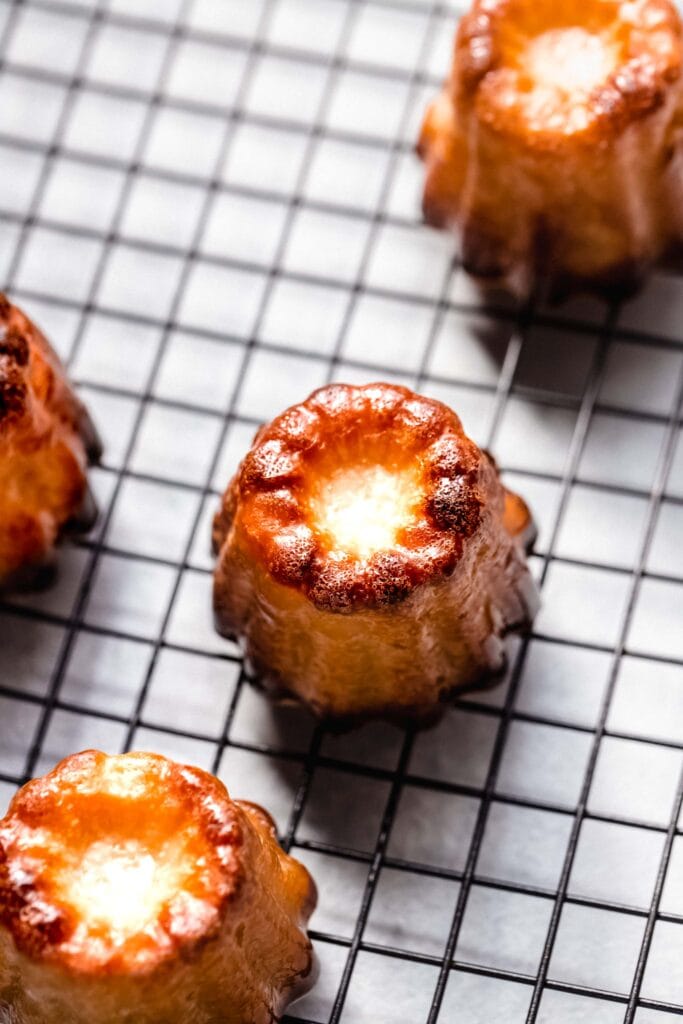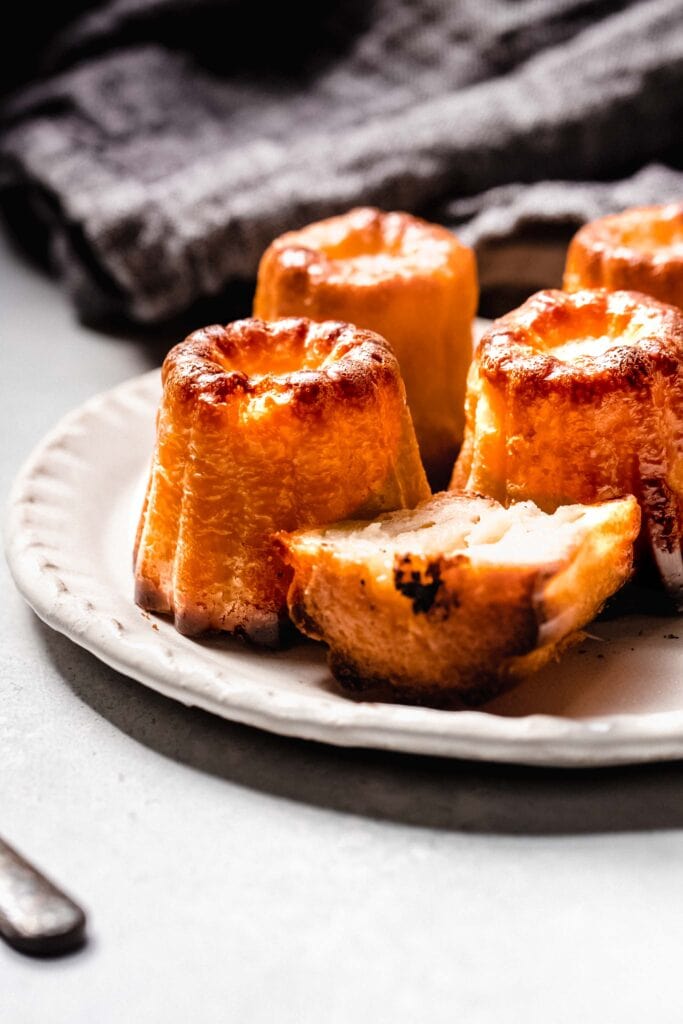It’s not the canele recipe that makes great caneles; it’s the process! With the right equipment and this tried-and-true technique, you’ll make perfect French caneles with crisp, caramelized shells and luscious custardy centers.

What is a canelé?
Canelé (pronounced “can-eh-lay”) is an elegant mini pastry made with milk, vanilla, butter, sugar, flour, and rum.
Not overly sweet, they’re like a handheld version of creme brulee.
If you haven’t tried these, you’re in for a yummy surprise. The size of small cupcakes, these custardy bites are flecked with vanilla and baked until the edges are deep amber in color.
“Canelé” is the French word for “fluted,” which refers to the signature flute-shaped molds, and “de Bordeaux” refers to the Bordeaux winemaking region in Southern France where this recipe originated.
Imagine a pudding-like batter flecked with vanilla beans and baked until the edges are beautifully caramelized.

What is canelé made with?
The technicality of canele leaves little room for fussing with the ingredients. Stick with this list and don’t make many substitutions if you can help it:
- Milk – It’s the base of the satiny-smooth batter. For a thicker batter, substitute half of the milk with heavy cream.
- Vanilla Bean – Scrape out those decadent vanilla beans from the inside of the pod for the absolute best flavor. If you can’t find vanilla beans, use quality pure vanilla extract.
- Unsalted Butter
- Powdered Sugar
- All Purpose Flour – The super fine and light texture creates an extra moist and tender crumb.
- Eggs
- Dark Rum – Canneles are traditionally made with dark rum, but cognac is an excellent substitution.
- Beeswax – This is traditionally used to coat the copper canele molds. It helps the pastries hold their shape while the edges caramelize and become deep amber in color.
How to make canelés de bordeaux
Begin by heating the milk and vanilla bean in a pot on the stove. Bring it up to a low boil, then take it off the heat and add the butter. Let the mixture cool slightly.
To make the canele batter, combine the powdered sugar and flour in a large bowl. Whisk the egg yolk, egg, and rum in a separate bowl. Finish by whisking the egg mixture into the dry mixture, followed by the lukewarm milk.
Strain the batter and refrigerate for at least 12 hours. This resting time is key to developing flavor in the batter. For the best results, let the batter rest 48 hours.
Coat your copper molds with beeswax butter (more on that below).
Finally, fill your prepped molds and bake at 460-degrees for the first 15 minutes before lowering the temperature to 375-degrees for the remaining time.
Let them cool a bit, then remove the caneles from the molds. Serve warm and enjoy!

Copper vs. silicone canele molds
A bit labor intensive, yes, but true French caneles are baked in copper molds coated in beeswax butter. The scorching heat in the oven develops caramelized, crispy crusts with smooth, creamy centers. You need 18 (2″ x 1″) canele molds to make this recipe.
- To prep copper molds: Melt beeswax and butter over low heat, then use a pastry brush to coat each mold. If the beeswax butter begins to thicken as you’re working, return it to the heat to loosen it up.
- To remove from copper molds: Flip each mold with tongs and tap gently until the pastry falls out. Use a paring knife to guide it out if you need to.
Copper molds are non-negotiable when it comes to making authentic canele, however, they can be pricey. A more budget-friendly option are these silicone molds.
- To prep silicone molds: No beeswax butter is necessary. Place the molds in the freezer for at least 30 minutes before filling them with batter.
- To remove from silicone molds: Use a kitchen towel to grip the bottom of each flute and gently squeeze to coax out the tiny cakes.

Expert tips
- Baking canneles in a convection oven ensures the pastries bake consistently. In a regular oven, you can gently pivot each mold a few times to help the pastries bake evenly.
- As hard as it may be to wait, you MUST let the batter sit in the fridge for 12 to 48 hours before baking. This gives the flavors time to get to know each other and the batter to become extra creamy and custardy.
- Keep a batch of batter chilled in small batches so you can bake fresh canele as often as you’d like!
How long do they last?
Homemade canneles are best when they’re still warm from the oven. The extras can be refrigerated in an airtight container for up to 2 days, but their quality declines the longer they sit.
Can you freeze them?
Yes! To freeze the baked caneles, wrap the individual pastries in plastic wrap and freeze in an airtight container for up to 1 month. To reheat, pop them in the oven at 500ºF until they’re as good as new.

Canele wine pairings
- A sweet, semi-dry French white Bordeaux is the perfect pairing.
- For something sweeter, serve with white dessert wines, like Moscato or Riesling. Champagne is always a good option for dessert as well!
More French dessert recipes
- Blackberry Galette
- Strawberry Galette
- Mocha Coffee Mousse
- Ricotta Mousse with Fresh Raspberries
- Baked Brie in Puff Pastry
- More → 35+ Traditional French Desserts
Did you make this canele recipe?
If you loved this recipe for cannelles, please leave a star review! Also, be sure to snap a picture of your finished treats to share with me on Instagram using the hashtag #platingsandpairings and tagging me @platingsandpairings!
For more great Platings and Pairings recipes, be sure to follow me on Instagram, TikTok, Pinterest and Facebook.

Canele Recipe
Ingredients
- 2 cups whole milk
- 1 vanilla bean (split lengthwise and scraped)
- 4 Tablespoons unsalted butter (½ stick )
- ⅔ cup all purpose flour
- 1 ¾ cup powdered sugar
- 1 egg yolk
- 2 eggs
- 3 Tablespoons dark rum
If Using Copper Molds:
- 3 ounces beeswax (finely chopped (about 1/3 cup, if using copper molds))
- 3/4 cup unsalted butter
Instructions
- In a small saucepan, combine the milk, vanilla bean, and its scrapings. Bring the milk just to a boil over medium high heat, then remove the pan from the heat and add the butter. Set aside to cool to lukewarm.
- In a large bowl, whisk together the powdered sugar and flour. In a separate small bowl, whisk together the egg yolk, eggs and rum. Whisk the egg mixture into the sugar and flour mixture, then whisk in the lukewarm milk mixture.
- Strain into a container; cover and refrigerate for at least 12 hours and up to 48 hours, the flavors will develop as the mixture sits.
- If using copper molds, melt the beeswax in a saucepan over low heat. Add the 3/4 cup butter to the melted wax and stir until the butter is melted. Remove the mixture from the heat and, using a narrow pastry brush, carefully coat the inside of 18 (2 by 1-inch) canneles molds. (Dedicate this brush to canneles making because the wax will get into the brush.) If the wax mixture starts to set up or thicken, return it to the heat for a moment until it thins.
- If using silicone molds, there is no need to coat them. However, they should be placed in the freezer for at least 30 minutes prior to using, in order to help develop a nice crust.
- Preheat the oven to 460-degrees (not convection).
- Place the molds on a rimmed baking sheet. When you’re ready to bake, fill each mold almost to the top.
- Bake for 15 minutes, then reduce the oven to 375-degrees.
- Bake for a further 45 minutes to 1 hour until the tops are a deep, golden brown, rotating once or twice during cooking to ensure even baking.
- Let cool slightly. To remove canelles from copper molds, turn each one over with a pair of tongs and tap until the canelle falls out. If difficult to remove, use a paring knife to help guide it out.
- If using silicone molds, use a dish towel to squeeze the bottom of each mold to help remove the canelles.
- Enjoy.
Nutrition
This canelles recipe was originally published in 2015. It was updated in 2022 to add new instructions and information.
Check out the web story here.









These look FABULOUS – thank you. I’ve collected several versions for these but yours seem simpler and easier. I look forward to trying your recipe.
Thanks Arline! They were easy to make – The silicone mold make it so much easier than I think the copper molds would be with the beeswax coating! Enjoy 🙂 I’m making another batch this weekend!
I tried canneles once in Paris and wasn’t really impressed, but I know so many people who love them that I have to believe I just didn’t have a great one. I’m intrigued by the use of beeswax, but I’d be with you in going for a silicone mold that didn’t require it.
That could be! Although, I’d think they’d be AWESOME in Paris! I hope you give them another try!
I love caneles, but I always assumed they would be way too difficult to make at home. Now I’d really like to try!
With the silicone molds, they’re really not too difficult at all! They just take a little pre-planning. I hope you give them a try Katie!
Hello! I purchased the silicone molds through the link you provided on Amazon but the molds are measuring 2×2 inches. On your recipe it says fill 18 2×1 molds. Will the cooking time have to be adjusted for the 2×2 mold? Looking forward to making these, thank you!
Hi Monica – In the recipe, the copper molds are the 2×1″ variety. You are correct that the silicone molds measure 2×2″. Please go ahead and use the instructions for the silicone variety baking and they should come out just right. I hope you love ’em! I’d love to hear back on how they turn out!!!
These caneles look great. They must be delicious as you said with a Tawny port. or even with a coffee. I’ve bought the silicone molds and saved the recipe. I’m eager to try it. I have already used the molds but for a kind of smoothie-on-a -stick. My kids just loved the idea. I’ll leave you the link if you wish to see it.
https://foodwithameaning.wordpress.com/2016/08/20/smoothie-on-a-stick-de-ameixa-e-framboesa/
Best regards
Patrícia
Your recipe looks great – I love finding new uses for baking products! I hope you enjoy the Caneles too Patricia!
Hello
Thanks for sharing the recipe
Looks yummy and fantastic
If I don’t want to use the rum and any other alcohol things, do u think there is gonna be huge difference
Have any suggestions or idea regarding that issue
Look forward to hearing from you
Narges
Hi Narges – You should be fine leaving the alcohol out completely. Hope that helps!
Hi. If I use the silicon molds and omit the beeswax, do I omit the butter too?
Hi Stacy – You should leave the butter.
Hi, for the silicone mold, do you recommend freezing the empty molds for the last 30 min the batter is sitting after removal from the fridge?
Hi Allison – That’s a great plan!
Allison, I don’t normally post but have to on this one. I tried making caneles before and it was a flop. After seeing your recipe, I was inspired to try again…and I’m glad I did. Your recipe was easy to follow and the result was amazing. Shared them with a friend who has never had a cancele before and she was hooked as well as her family. Thanks for sharing the recipe. Suzie